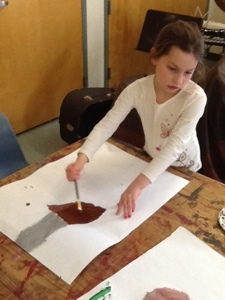Fifth and sixth graders are studying Africa in their classrooms. As part of this study, they learned about tribal masks. Using paper mache and natural materials, they created large tribal masks based on the traditional masks that they researched. I invited a sixth grader to share the mask-making process and some information about her mask in this guest post.
Kwele Mask
by Ciera
Recently, we have been working on making African masks. We have now finished painting our masks, and this is how mine looks. It seems hard to believe how it started as a big box, and now it has a shape and is painted.
Day 1:
On day one, we shaped our masks, and started to build it up. I taped on antlers and built up the eyes.
Day 2:
On day two, we started to cover our masks with paper mache. It was sort of falling apart at that point. It took some duct tape to hold it together.
Day 3:
On day three we painted a base layer of white paint.
Day 4:
On day four, we added color to our masks.
My mask was based on a mask from the Kwele tribe. The Kwele originated near the borders of Gabon, Cameroon, and Congo. The masks were used in the 'Beete' ritual. In the Beete ritual involved Ekuk masks. Ekuk means 'spirit of the forest'. The Kwele believed in witchcraft, and the Beete ritual is supposed to help protect them from it. The masks sometimes represent the antelope that is eaten after the ritual. The Kwele used to live more toward the coast, but their enemies got firearms and they were forced to move inland.
One of the challenges for me was to get the shape of the mask right. It took a while because it was so big, and it was hard to staple and the scored edges together. Another of my challenges was getting the whole mask covered in paper mache and the coat of white paint. I enjoyed designing my mask and painting it. I enjoyed making my mask and learning about the tribe that it belonged to. I think that my mask looks awesome.
Here are some other tribal masks by fifth and sixth graders.























































